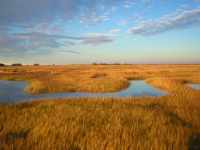1 December 2010
WASHINGTON—Many coastal wetlands worldwide, including several on the U.S. Atlantic coast, may be more sensitive than previously thought to climate change and sea-level rise projections for the 21st century.
Scientists engaged in an international research modeling effort have made this conclusion in a paper published today in Geophysical Research Letters, a journal of the American Geophysical Union. The researchers identified conditions under which coastal wetlands could survive rising sea level.

The marshes of Plum Island Estuary, in Massachusetts, are among those predicted by scientists to submerge during the next century under conservative projections of sea-level rise.
Credit: Matthew Kirwan,USGS
Get the high resolution copy of the image
Using a rapid sea-level rise scenario, most coastal wetlands worldwide will disappear near the end of the 21st century, the research team finds. Using the contrasting slow sea-level rise projection, wetlands with low sediment availability and low tidal ranges are vulnerable and may drown. However, in the slow sea-level rise projection, wetlands with higher sediment availability would be more likely to survive.
Several coastal marshes along the east coast of the United States, for example, have limited sediment supplies and are likely to disappear this century. Vulnerable east coast marshes include the Plum Island Estuary (the largest estuary in New England) and coastal wetlands in North Carolina’s Albemarle-Pamlico Sound (the second largest estuary in the United States).
“Accurate information about the adaptability of coastal wetlands to accelerations in sea-level rise, such as that reported in this study, helps narrow the uncertainties associated with their disappearance,” said Glenn Guntenspergen, a scientist with the U.S. Geological Survey (USGS) and an author of this report. “This research is essential for allowing decision makers to best manage local tradeoffs between economic and conservation concerns.”
“Previous assessments of coastal wetland responses to sea-level rise have been constrained because they did not consider the ability of wetlands to naturally modify their physical environment for adaptation,” said USGS scientist Matt Kirwan, also an author of the report. “Failure to incorporate the interactions of inundation, vegetation and sedimentation in wetlands limits the usefulness of past assessments.”
The research team specifically identified the sediment levels and tidal ranges (difference between high and low tide) necessary for marshes to survive sea-level rise. As water floods a wetland and flows through its vegetation, sediment is carried from upstream and deposited on the wetland’s surface, allowing it to gain elevation. High tidal ranges allow for better sediment delivery, and the higher sediment concentrations in the water allow wetlands to build more elevation.
Coastal wetlands provide critical services such as absorbing energy from coastal storms, preserving shorelines, protecting human populations and infrastructure, supporting commercial seafood harvests, absorbing pollutants and serving as critical habitat for migratory bird populations. These resources and services will be threatened as sea-level rise inundates wetlands.
The rapid sea-level rise scenario used as the basis for this study is accredited to Stefan Rahmstorf at Potsdam University, in Potsdam, Germany , one of the contributing authors of the Intergovernmental Panel on Climate Change Fourth Assessment Report. The slow sea-level rise projection is from the A1B scenario of the Intergovernmental Panel on Climate Change Fourth Assessment Report.
Joint Release
Peter Weiss, +1 202 777 7507, [email protected]
Catherine Puckett, +1 352 264 3532, [email protected]
Journalists and public information officers (PIOs) of educational and scientific institutions who have registered with AGU can download a PDF copy of this paper in press
Or, you may order a copy of the final paper by emailing your request to Peter Weiss at [email protected] or to Catherine Puckett at [email protected]. Please provide your name, the name of your publication, and your phone number.
Neither the paper nor this press release are under embargo.
Images:
Images and captions relevant to this release are available, and can be downloaded, at http://gallery.usgs.gov/tags/NR2010_12_01
“Limits on the adaptability of coastal marshes to rising sea level”
Matthew L. Kirwan: Patuxent Wildlife Research Center, U.S. Geological Survey, Laurel, Maryland, USA, and Department of Environmental Science, University of Virginia, Charlottesville, Virginia, USA;
Glenn R. Guntenspergen: Patuxent Wildlife Research Center, U.S. Geological Survey, Laurel, Maryland, USA;
Andrea D’Alpaos: Dipartimento di Geoscienze, Universita di Padova, Padua, Italy;
James T. Morris: Belle W. Baruch Institute for Marine and Coastal Sciences, University of South Carolina, Columbia, South Carolina, USA;
Simon M. Mudd: School of GeoSciences, University of Edinburgh, Edinburgh, UK;
Stijn Temmerman: Department of Biology, University of Antwerpen, Wilrijk, Belgium.
Glenn R. Guntenspergen, Tel. +1 (218) 720-4307, [email protected]